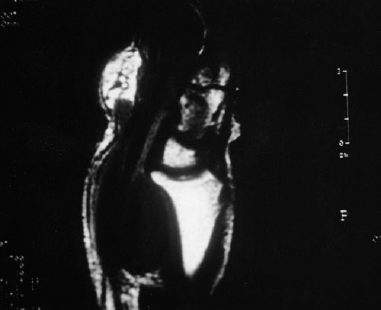11
Mycobacterial Tenosynovitis
John C. P. Floyd and Waldo E. Floyd III
History and Clinical Presentation
A 66-year-old man employed as a machinist was referred for further evaluation of limited range of motion and swelling in his left hand and distal forearm, which had been progressive over the past 8 months. The patient had been impaled over the volar aspect of the volar forearm by a saltwater catfish fin 18 months previously. The patient’s surgical and medical history was otherwise negative.
Physical Examination
The patient had limited range of motion in the thumb and small finger and a 4 × 5 cm cystic mass over the volar aspect of the wrist and distal forearm (Fig. 11–1). Over the volar aspect of the thumb, there was marked swelling about the flexor tendon sheath. To a lesser degree, the small finger was also swollen over the flexor sheath and rested in slight flexion at the interphalangeal joints. There was limitation of composite digital flexion, but all flexor tendons were intact. Neurovascular examination of the hand was normal. No evidence of axillary or epitrochlear node involvement was present.
Diagnostic Studies
Anteroposterior and lateral radiographs of the left hand were positive for soft tissue swelling. No evidence of osseous involvement was present. A magnetic resonance imaging scan demonstrated a 4 × 5 × 3 cm mass volar to the pronator quadratus without evidence of bone involvement (Fig. 11–2). The mass was homogeneous and had a signal intensity consistent with soft tissue.

Figure 11–1. (A) Progressive hand and wrist swelling. (B) Eighteen months following a penetrating volar wrist injury by a saltwater catfish. (With permission from Floyd WE III, Foulkes GD. Tuberculous, mycotic, and granulomatous disease. In: Peimer CA, ed. Surgery of the Hand and Upper Extremity, 1st ed. New York: McGraw-Hill; 1996.)
PEARLS
- High index of suspicion
- Obtain a thorough history of possible exposure
- Surgical debridement is key to affecting a cure
- Obtain infectious disease consultation
PITFALLS
- For species-specific diagnosis, culture is necessary.
- Treatment should be modified to the specific species.

Figure 11–2. Magnetic resonance imaging scan demonstrating a solid soft tissue mass volar to the pronator quadratus. (With permission from Floyd WE III, Foulkes GD. Tuberculous, mycotic, and granulomatous disease. In: Peimer CA, ed. Surgery of the Hand and Upper Extremity, 1st ed. New York: McGraw-Hill; 1996.)
Differential Diagnosis
Neoplasm
Fungal infection
Mycobacterial infection
Bacterial infection
Diagnosis
Microbacterial Infection
The diagnosis was a horseshoe abscess of noncaseating granulomatous disease secondary to mycobacteria other than tuberculosis (MOTT). Cultures were positive for Mycobacterium avium-intracellulare complex.
A major cause of granulomatous infections is mycobacteria. Two of the earliest identified mycobacteria were Mycobacterium tuberculosis and Mycobacterium leprae. Tuberculosis remains the most common pathologic organism of this genus. Hansen’s disease or M. leprae
Stay updated, free articles. Join our Telegram channel

Full access? Get Clinical Tree








